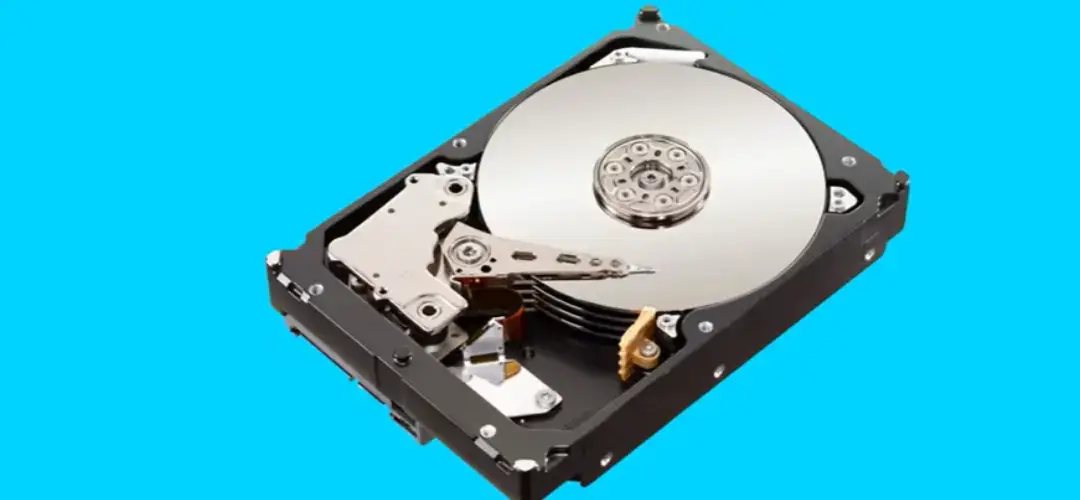What is Hard Disk Drive(HDD)|Definiton, types &Features
Introduction
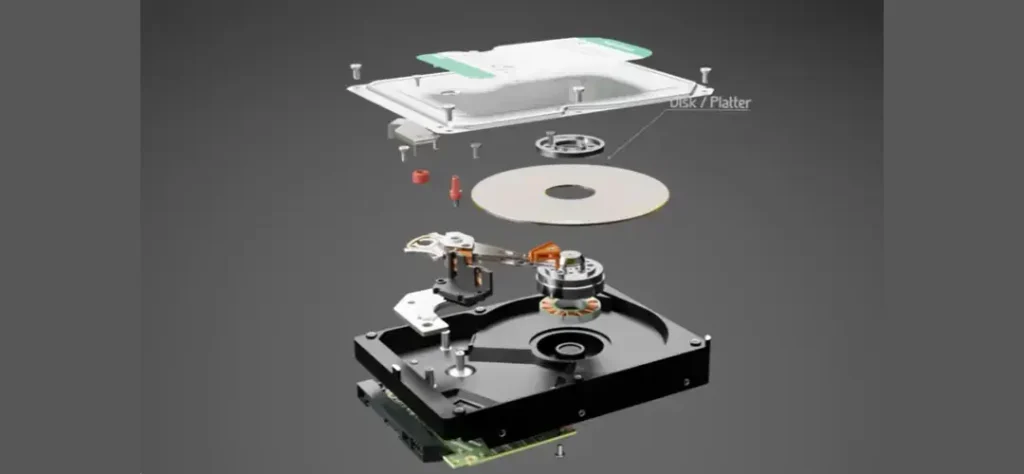
In the digital era, where data is the lifeblood of businesses and individuals alike, storage solutions play a crucial role in preserving and accessing information efficiently. Among the various storage options available, the Hard Disk Drive (HDD) remains a suitable option that offers reliable and cost-effective storage solutions for a wide range of applications. This article will help you to understand the history, types, functions, and significance of Hard Disk Drive(HDD).
History of Hard Disk Drive
Hard Disk Drive(HDD), also known as Secondary Storage, was invented by IBM’s Engineers at the San Jose California Laboratory. The history of hard disk drives traces back to the mid-20th century, marked by the introduction of the IBM 350 RAMAC by IBM in 1956. The IBM 350 RAMAC was the world’s first commercially available HDD, boasting a storage capacity of 5 megabytes and utilizing fifty 24-inch platters. Since then, HDD technology has evolved rapidly, with successive generations witnessing significant advancements in capacity, speed, and reliability. Today, HDDs are found in everything from personal computers and laptops to enterprise-grade storage systems.
What is a Hard Disk Drive?
Computers rely on Hard Disk Drives to Store Data Permanently. A hard disk drive, commonly referred to as an HDD, is a non-volatile storage device used for the storage and retrieval of digital data. It consists of several key components, including platters, read/write heads, an actuator arm, a spindle motor, and a controller board. These components work in tandem to store and access data efficiently.
Types of Hard Disk Drives
There are different types of Hard Disk Drives such as:
- Parallel Advanced Technology Attachment (PATA)
- Serial Advanced Technology Attachment (SATA)
- Small Computer System Interface(SCSI)
- Solid State Drive(SSD)
1-Parallel Advanced Technology Attachment (PATA)
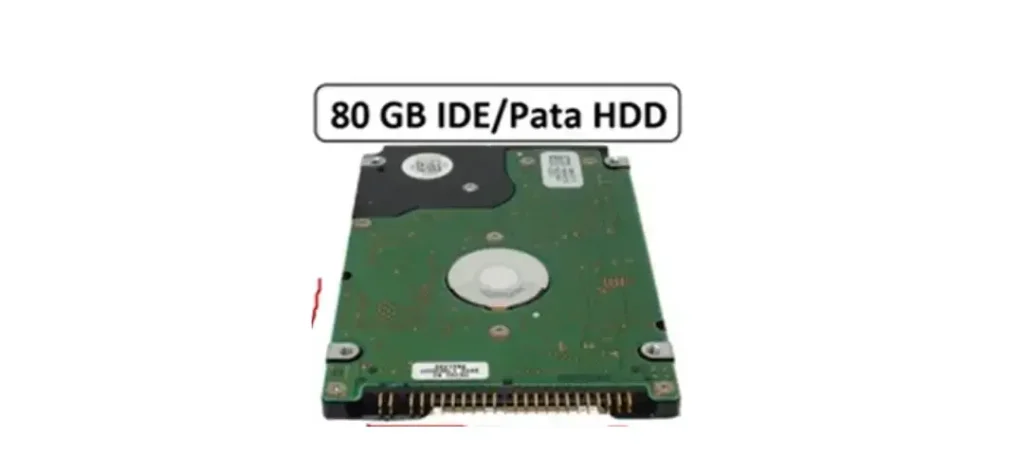
Parallel ATA(PATA) drives are one of the hard drive types, also known as Integrated Drive Electronics(IDE) or Enhanced Integrated Drive Electronics(EIDE) drives. It is the first Hard Drive Connected to a Computer Using the PATA Interface Standard. The PATA Drive was developed by Western Digital in 1986. PATA Drives can Provide a data transfer rate of up to 133 MB/s. In the master/slave configuration, two PATA drives can be connected with one cable.
Advantages of PATA Drives
The advantage of PATA is that the PATA Cables have two devices attached to the cable at one time. One is referred to as device 0(master) and the other as device 1(slave). A common misconception about using two devices on one cable is that they can only run as fast as the slowest device.
Disadvantages of PATA Drives
One of the disadvantages of PATA Cable is that it is really big. When the cable is laid on other equipment, this will make the cable bundling and management more difficult. Similarly large PATA Cables make it difficult to cool computer components because the airflow must bypass larger cables. Another disadvantage of PATA Cable is that it is very expensive because it costs more to manufacture one.
2-Serial Advanced Technology Attachment (SATA)
As one of the HDD types, Serial ATA(SATA) Hard Drives are still considered to be the most common type of Hard Drives used today. It almost Supports all computer motherboards and operating systems. SATA Drives are usually one of two sizes, 3.5-inch hard drives for desktop computers and 2.7-inch small hard drives for laptop computers. Apart from desktop computers and laptops, SATA Hard drives can also be found inside video gaming consoles, including the PlayStation 3 and 4, the Xbox 360 and One, and many others. The disk of the SATA drive rotates at different speeds according to the model purchased. The speed can reach 10,000 RPM to increase data transmission. Storage devices used in large servers can even reach 15,000 RPM. However, Higher RPM SATA drives are also more prone to failure. Mechanical failure is one of the main disadvantages of SATA drives.
3-Small Computer System Interface(SCSI)
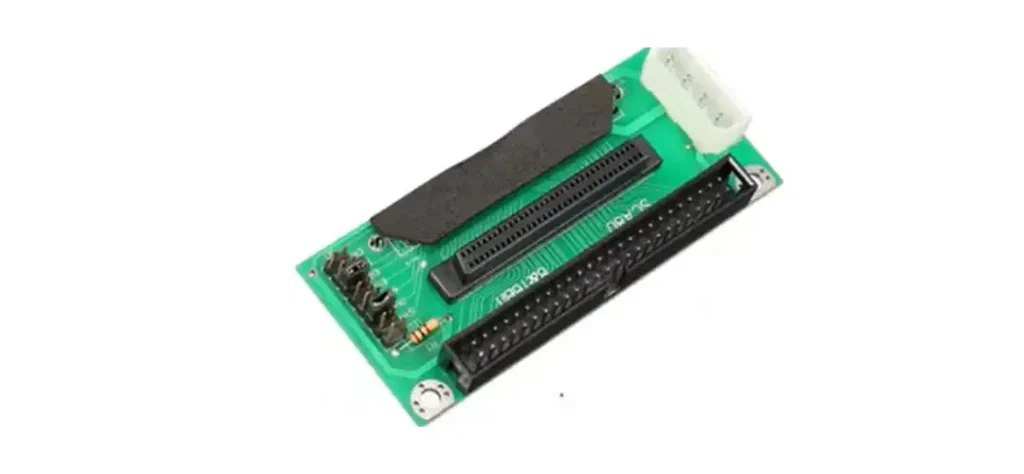
Small Computer System Interface is also one of the types of Hard Disk. It was developed in the 1970s and was first called Shugart Associates System Interface(SASI) after the company founded it. It uses a 50-pin flat ribbon connector to connect hard drives and other peripherals to the computer. With standard interface technology, 7 to 15 devices are allowed to connect to a single motherboard. Although it is generally believed that SCSI is outdated, the SCSI can still be found in some low-end computers. Modern SCSI Cables can transfer data at up to 80 MB/s. Although it is generally believed that SCSI is outdated, the SCSI can still be found in some low-end computers. Modern SCSI cables can transfer data at up to 80 MB/s.
4-Solid State Drive(SSD)
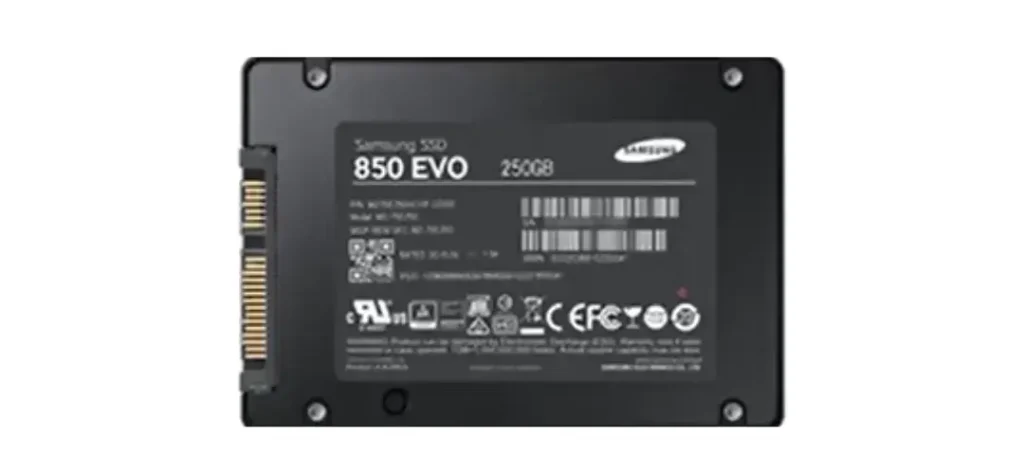
Solid State Drive (SSD) is a solid-state storage device that uses integrated circuit assemblies as memory to store data. SSD is also known as Solid-State Disk although SSDs do not have physical disks. There are no moving mechanical components in SSD. This makes them different from conventional electromechanical drives such as hard disk drives(HDDs) or floppy disks, which contain movable read/write heads and spinning disks. SSDs work using the concept of flash memory, which is the same concept used in the random access memory(RAM) of the Motherboard. SSDs are typically more resistant to physical shock, run silently, and have quicker access time and lower latency compared to electromechanical devices. The biggest advantage of an SSD is that it is not prone to failure. However, the biggest disadvantage of an SSD is the price. With the same storage space, the cost of SSD is three to four times that of SATA hard drives.
The architecture of Hard Disk Drive HDD
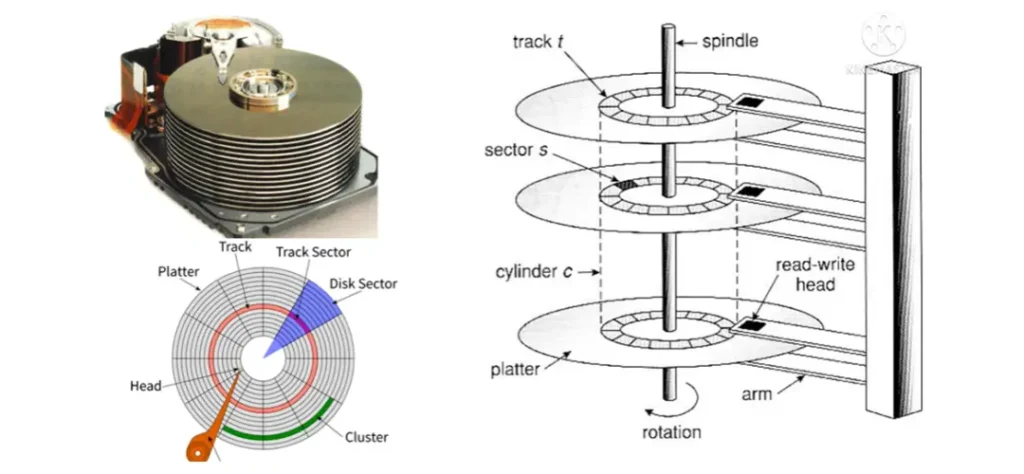
Why do Computers Need Hard Disk Drive?
Hard disk drives are indispensable components of modern computers and digital devices, serving as the primary means of long-term storage for operating systems, applications, documents, media files, and other data. Unlike volatile memory such as RAM, which loses its contents when power is removed, HDDs retain data even when the power is turned off, making them ideal for storing data that needs to be preserved over extended periods.
How Does a Hard Disk Drive Work?
At the heart of every hard disk drive are rotating platters coated with a magnetic material. Data is stored on these platters in the form of magnetic patterns, with each pattern representing a bit of information. To read or write data, read/write heads mounted on an actuator arm move rapidly across the surface of the spinning platters, magnetizing or demagnetizing the magnetic material to encode or decode data. The spindle motor spins the platters at a constant speed, typically measured in revolutions per minute (RPM), ensuring that data can be accessed quickly and efficiently.
Components of Hard Disk Drives
- Platters
- Read/Write Heads
- Actuator Arm
- Spindle Motor
- Controller Board
- Head Stack Assembly
- Voice Coil Motor
- Controller Chip
- Gasket
1-Platters
Platters are the circular, metal discs within the hard disk drive where data is stored. These platters are typically made of aluminum or glass and are coated with a thin layer of magnetic material. Data is written and read from these platters using magnetic heads.
2-Read/Write Heads
Read/write heads are small electromechanical components located at the end of the actuator arm. Their primary function is to read data from and write data onto the magnetic surface of the platters. These heads float just above the platter’s surface on a thin cushion of air created by the spinning motion of the platters.
3-Actuator Arm
The actuator arm is a mechanical component that holds the read/write heads and positions them over the surface of the platters. It moves the heads back and forth across the radius of the platters to access different tracks and sectors where data is stored.
4-Spindle Motor
The spindle motor is responsible for spinning the platters at a constant speed. It ensures that the platters rotate smoothly and consistently, allowing for efficient data access and transfer. The speed of rotation, measured in revolutions per minute (RPM), affects the performance of the hard disk drive.
5-Controller Board
The controller board, also known as the disk controller or PCB (Printed Circuit Board), is the electronic circuitry that manages the operation of the hard disk drive. It acts as an interface between the HDD and the computer system, controlling data transfer, error correction, and other essential functions. The controller board also contains firmware, which is software embedded within the HDD to control its operation and manage data.
6-Head Stack Assembly
There is a Head Stack Assembly, with one arm above and one arm below each disc, and with a slider and a read/write head at the end of each arm. The slider is uniquely designed such that it catches the airflow generated by the ludicrously fast-spinning disk and uses the airflow to float or fly the read/write head so that it’s only 15 nanometers or about 100 atoms away from the surface of the disk. For reference, here is the thickness of a sheet of aluminum foil. Because the arm assembly flies on top of the spinning disk, it’s only brought over the surface when it’s at full speed, and when the disk is not spinning the arm assembly is parked to the side on a small piece of plastic.
7-Voice Coil Motor
Back here a voice coil motor composed of a coil of wire and two strong neodymium magnets above and below is used to move the entire arm stack assembly. When ELectric Current is run through the coil it creates an electromagnet which is influenced by the neodymium magnets, thus generating a force that causes the arm to move across the disk. When a reverse current is sent through the voice call, the arm is forced in the opposite direction, thereby enabling control of the exact position of the read/write head within 30 or so nanometers. Additionally, the magnets and voice coil make a rather strong motor that enable the lightweight arm stack assembly and read/write head to move back and forth to different tracks across the platter up to 20 times a second and to make small adjustments incredibly fast. In order to connect to the read/write head, a flexible ribbon is routed along the side of the arm and down to this connector which feeds signals to the outside of the hard disk drive enclosure and to the printed circuit board or PCB. on the PCB we have the main Processor as well as DRAM Chip, which is used as a scratchpad for the Processor and a buffer for the incoming and outgoing data.
8-Controller Chip
Additionally mounted on the PCB is a chip for Controlling the voice coil and brushless DC Spindle motor, and then on the edge of the PCB is a SATA Connector which connects to the Motherboard for Communications and a Separate Connector that goes to the power supply.
9-Gasket
Additional Important components are a Gasket that seals the disk from the exterior environment and two filters that catch any stray dust Particles. These filters are necessary since the read/write heads are just 15 nanometers away from the platter, and a single dust particle can be up to 10,000 nanometers large and could cause major damage if it were to collide with the 7200 rpm disk.
Hard Drive Components and Form Factors
In addition to the internal components mentioned above, hard disk drives come in various form factors, including 3.5-inch and 2.5-inch drives. These form factors determine the physical size and shape of the hard drive, making them suitable for different types of devices such as desktop computers, laptops, and servers. Additionally, hard drives may have different interfaces, such as SATA (Serial ATA) or SAS (Serial Attached SCSI), which dictate how they connect to a computer or storage system.
Hard Disk Drive Storage Capacity
The storage capacity of hard disk drives varies depending on factors such as the number of platters, data density, and form factor. HDDs are available in capacities ranging from a few gigabytes to multiple terabytes, catering to diverse storage requirements.
Common Hard Disk Drive Errors
Despite their reliability, hard disk drives are susceptible to errors and failures due to factors such as mechanical wear, electrical issues, and logical errors. Common HDD errors include bad sectors, disk fragmentation, and mechanical failures. Bad sectors are areas on the disk where data cannot be reliably written or read, resulting in data loss or corruption. Disk fragmentation occurs when files are split into multiple fragments scattered across the disk, leading to slower performance and reduced efficiency. Mechanical failures, such as a malfunctioning spindle motor or actuator arm, can render the hard drive inoperable and result in permanent data loss.
Hard Disk Drive (HDD) Evolution and Technology Developments
Over the years, hard disk drives have undergone significant advancements in terms of storage density, performance, and reliability. Technological innovations such as perpendicular recording, shingled magnetic recording (SMR), and helium-filled drives have enabled manufacturers to increase storage capacities while improving data access speeds and energy efficiency. These advancements have driven down the cost per gigabyte of storage, making HDDs an economical choice for both consumer and enterprise applications.
Difference Between Hard Disk Drive(HDD) and Solid State Drive(SSD)
While HDDs and Solid State Drives (SSDs) serve the same purpose of storing data, they differ in terms of technology, performance, and price. HDDs use spinning disks and magnetic storage to store data, whereas SSDs utilize flash memory chips for faster access speeds and greater durability. SSDs have no moving parts, making them less susceptible to mechanical failures and capable of delivering significantly faster read and write speeds than HDDs. However, SSDs are generally more expensive on a per-gigabyte basis and have lower overall capacities compared to HDDs.
Advantages and Disadvantages of Hard Disk Drives
Hard disk drives offer several advantages, including high storage capacity, affordability, and compatibility with a wide range of devices and operating systems. HDDs are also well-suited for storing large files and archival data that do not require frequent access. However, HDDs have certain limitations, including slower read and write speeds compared to SSDs, susceptibility to mechanical failures, and higher power consumption. Additionally, HDDs are more prone to damage from physical shocks and vibrations, making them less suitable for mobile devices or environments with high levels of vibration.
Conclusion
In conclusion, hard disk drives remain a cornerstone of modern computing, providing reliable and cost-effective storage solutions for a wide range of applications. Understanding the history, functionality, and components of HDDs is essential for making informed decisions regarding storage options in computing environments. As technology continues to advance, HDDs are expected to coexist alongside emerging storage technologies, ensuring the continued availability of efficient data storage solutions.

